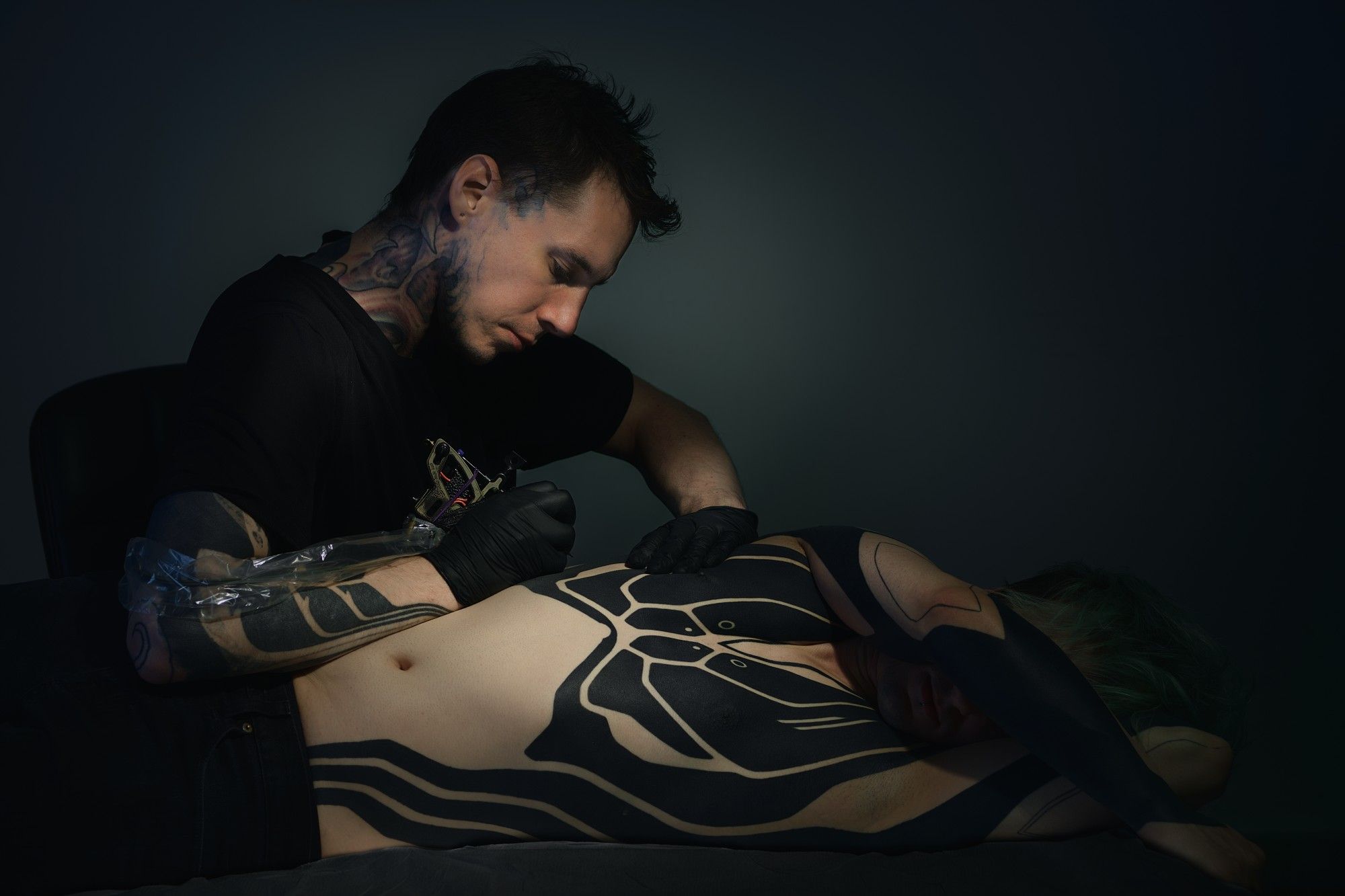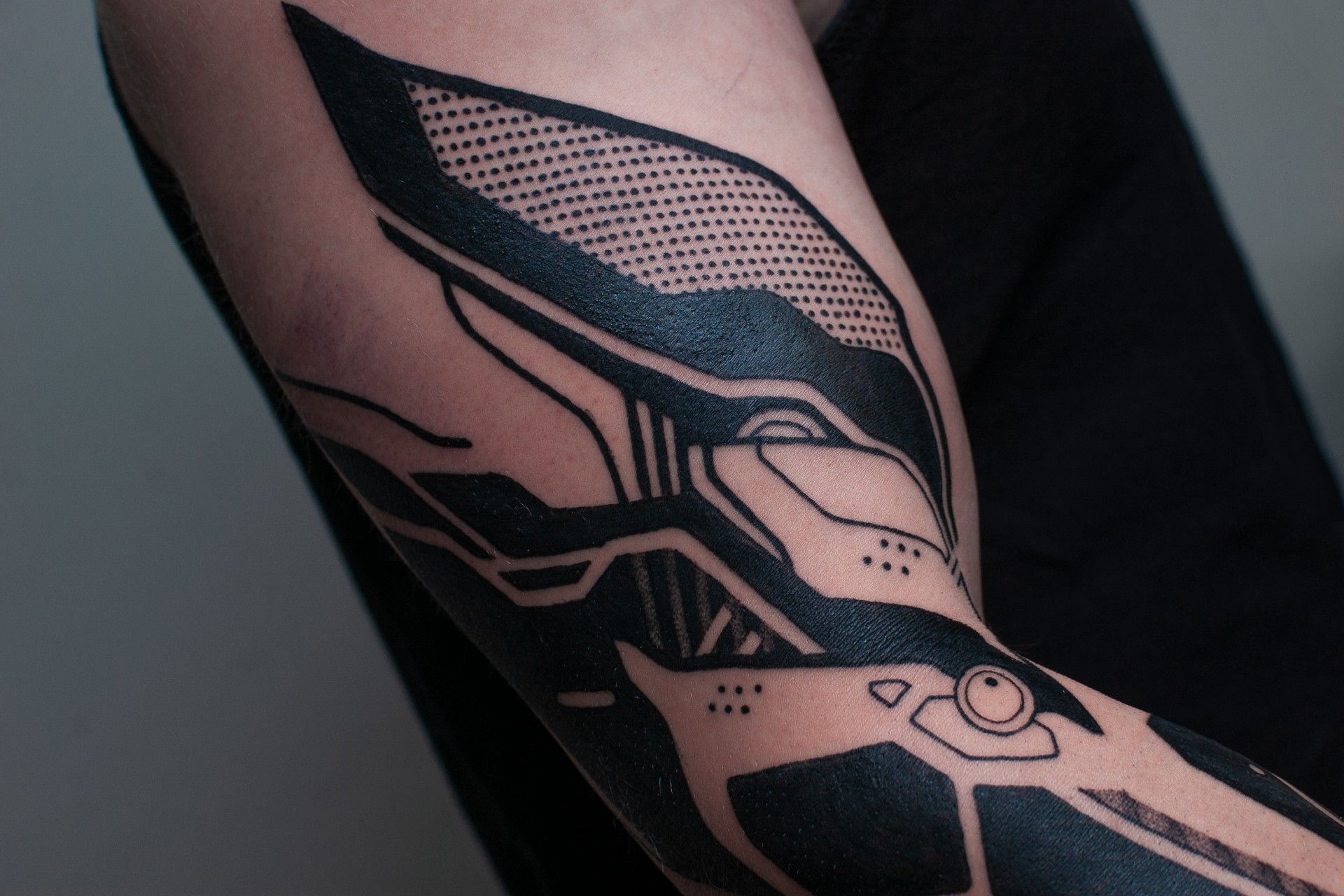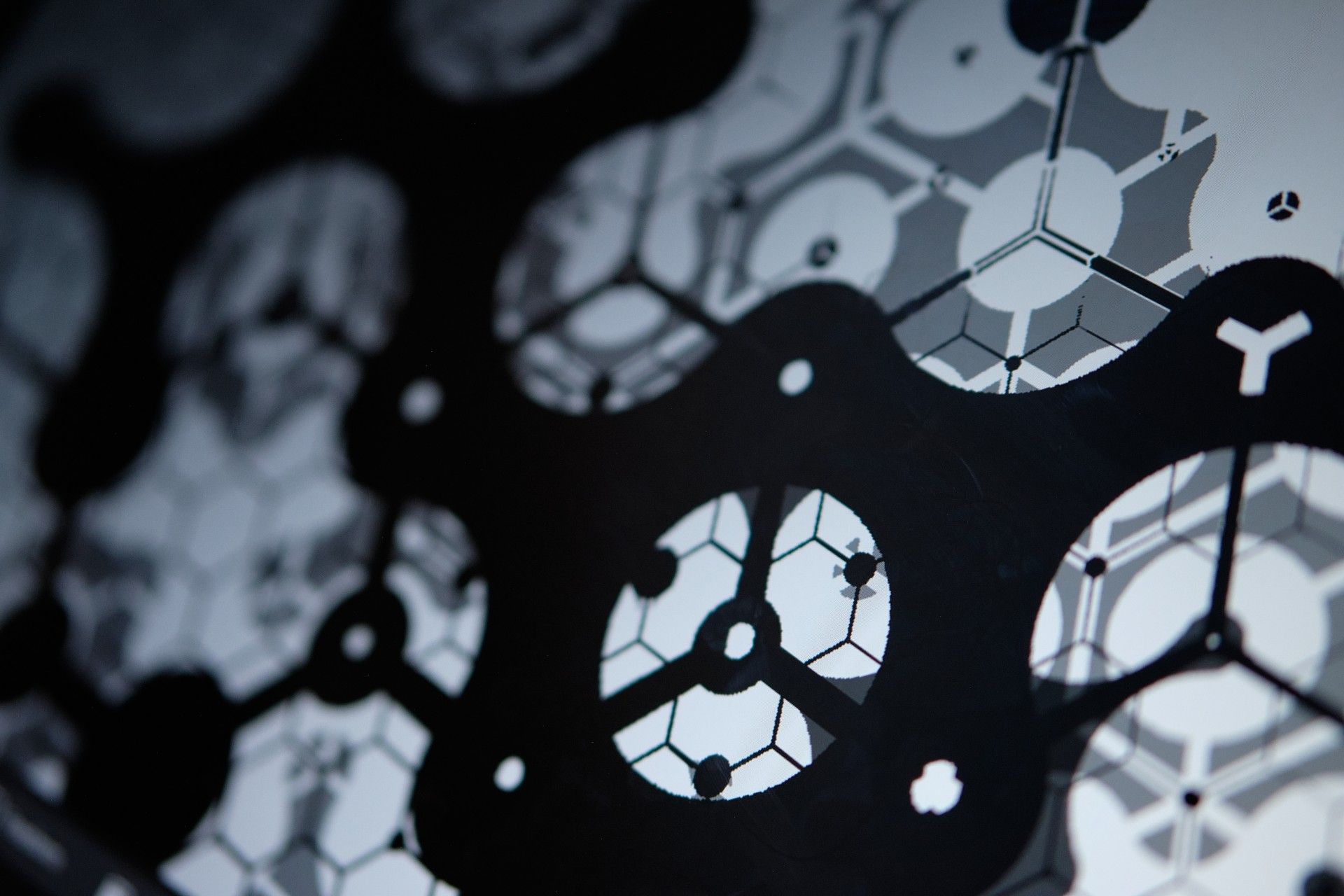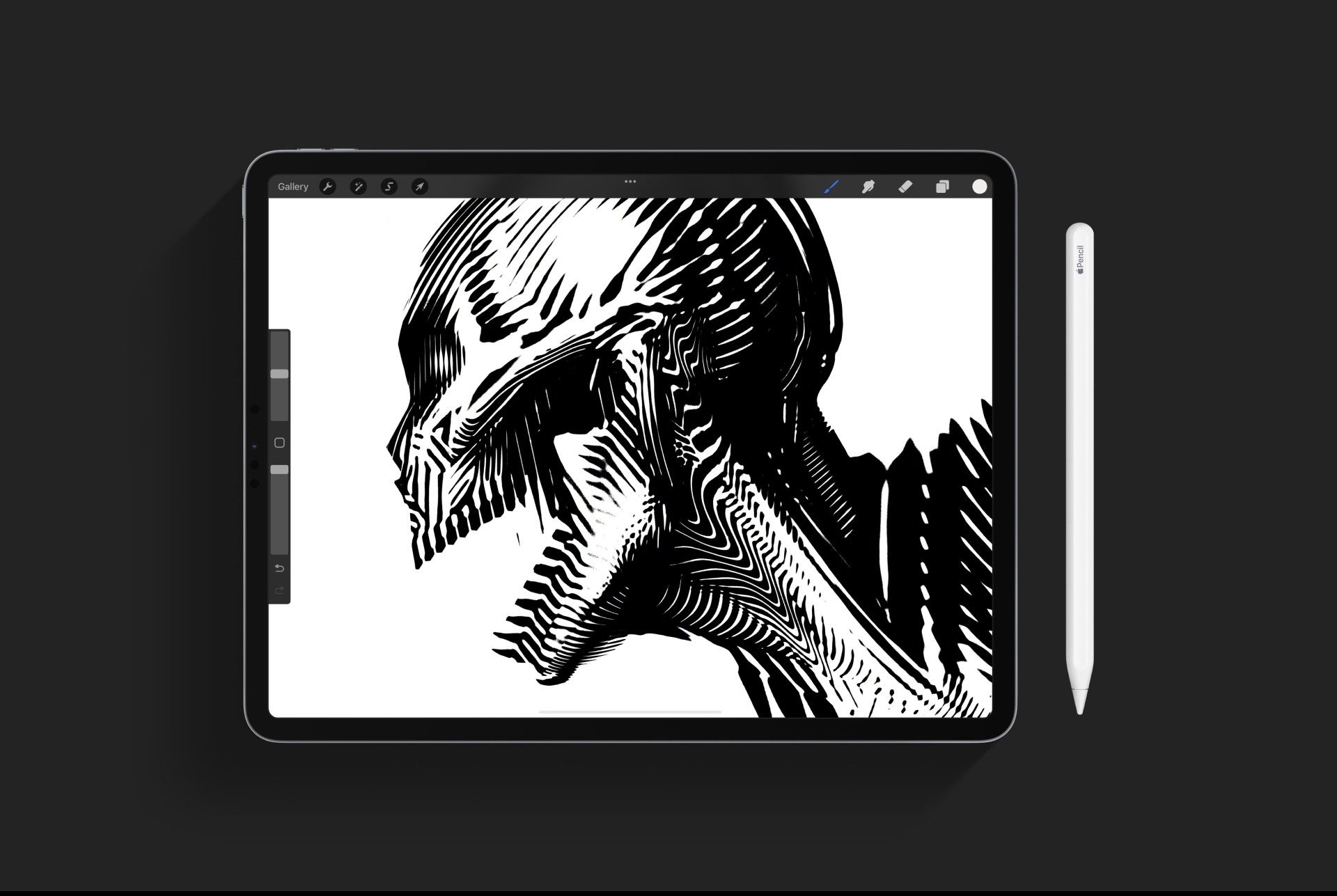
Brad Wooten is an experimental digital and body artist who works purely in black and is heavily influenced by Cyberpunk, Tech-Noir and Biomechanical designs. His linear and geometrical Cyberfluidics brush sets for Procreate are inspired by nature, organic patterns, generative art and parametric design, and live up to his claim of ‘using Procreate in ways it was never intended.’
Like most in his industry, behind the functional job title of ‘tattooist’ lies an extremely accomplished and talented artist who has, “been drawing about as long as I've been talking.” What sets Brad apart from most of his contemporaries is a rich technical mind seeking to make sense of his chaotic creativity by exploring structure, pattern and order. Where most turn to academia to help solve this puzzle, Brad decided to explore his creativity through his artistic intuition.
Having explored various other creative mediums such as writing and oil painting, tattooing became an all encompassing obsession and creative outlet for Brad. “I find it almost impossible to do a piece of art without thinking about how it could fit onto a person. It just never feels real, or complete until it's on a living thing. I would love to paint again, but every time I get started I always think, ‘Well, when's it going to be a tattoo?’”

Unlike other art forms, tattooing brings with it the unique aspect of existing on a living, thinking and feeling canvas. There is much more to body art than putting needle to skin. Its process is inherently transformative for the ‘canvas’, and places the artist in a very unique and personal situation that comes with great responsibility. “There's really nothing like changing someone's life like that, and going through that whole process with a person. Turning over every stone with them during the design, and then they commit to all that pain and have faith in you to go through this with them. Russ Abbott, a tattoo artist in Atlanta has said, ‘Most people get a tattoo during a period of growth or loss,’ almost every time I've noticed. It's also something I'm careful of when I'm talking to people.”
A living canvas also brings its own set of unique technical challenges, “The medium calls for immense respect of the content that it's going on top of, and for me I don't think of tattoos as a place to put something that you would otherwise put on the flat surface of a poster, painting or mural. It’s about the composition and you can't compose for a body the same way you do for a piece of [traditional] artwork. In composing a piece of artwork the only two things that you have to get started with are the aspect ratio: Is it tall or is it wide? It'll tell you a lot about where to lay your first mark, but there's no other dimensions to really work with. Even with product design if you have a curved object, most of the time designers will say, ‘Let's put a stamp here, that's a flat area.’ and that's fine for a simple shape but a body is living, breathing. This canvas really is alive.”

Mastering the intricacies of producing art on a living canvas isn’t something taught in textbooks, but rather by practicing and perfecting at every given opportunity. Knowing college wasn’t for him, Brad began a four-year apprenticeship at a studio in New Orleans. “Then I lived and worked in Seattle for six years. And that's where I made some bigger decisions about the style I wanted to work in, and the way I thought about tattooing as well. Toward the end, I had some personal stylings wash over me that I wanted to explore, so I made of batch of personal designs to spearhead a new direction. Then I moved out to Maine and I put that whole plan into action. I've been here for the past five years or so, just trying to be as successful as I can.”
Brad’s thoughtful and respectful approach to his craft helped him develop his style, which has manifested in a collection of bold signature artworks that speak as loud as the individuals they are inked upon. “Tattoos need to be there or not be there, is what I found. Some of the older style of tattooing, some more ancient types, had it figured out: black.”
“I want my tattoos to be visible across the street. I want my tattoos to be visible in the dark, in a club. I want them to not be inhibited by the space around them at all. But also under light, I want details to emerge and everything to be nice and clean. You want, as a designer, your tattoos to compliment the body and also appear to have a life of their own, to lean the strengths of the body and tattoo idea into one another. Dominance by itself is not enough and whatever intention that this tattoo has, you want that to come forward. Maybe it's to highlight a feature of the body, or make it look delicate, or subtle, or hard, or square, or tough, or soft. I always aim to make that original intention clear.”

An early obsession with the video game series Armored Core is perhaps the earliest driver in influencing Brad’s thinking around his direction and work. “You'd customize parts together, and build mechs out of a spreadsheet of parts. And I would do that more than playing the actual game, I would just work with the spreadsheets on the game, seeing which ways I could manipulate the numbers to find a fun and novel way to play.”
This obsession with interconnected design led Brad to exploring geometry and designs that unify and work together. It’s an influence also evident in the brush creation for his Cyberfluidics brush packs for Procreate. “That's how I ended up with questions around unifying those brushes together, and how I could make them compatible with each other so that they're all geometrically aligned. It came from me playing all those video games and working with multiple parts that you could interchange out. Tweaking those tiny dials to get things exactly the way you wanted.”
It’s an unusual influence that led to a unique art style, and an even more unique set of Procreate brushes. Similar to designing mechs in Armored Core, Brad’s approach to Procreate’s Brush Studio was to “make sets of geometrically compatible motifs, and use them as a grain source with some special blending modes. This gives it the growth effect that unifies the different patterns on the canvas. And in the [Cyberfluidics] brush pack every brush is a compacted version of what I normally do [as a process]."
"In most of my designs I work with the pattern layer separate from the value layer. What I did for the brush pack was bake that effect into the brushes. It was far too much to ask people to, ‘Take this soft brush and put another layer over on top of it, and set it to this and then see what happens.’ I thought, ‘Well, no, I'm sure I could put those elements together to get a reactive brush that does all of that automatically.’ So instead of multiple layers, only one layer is needed to get started with a similar effect. But you can still use two layers if you want more control.”
“The way those brushes basically work is through a threshold filter. For the effect I needed to separate the value map, which is what I call the object that the finished image may look like, from the pattern that would be affected by the object's values to render the final look. That way, I could play with each element non-destructively. I went into Illustrator and I made some repeating gradient vectors. The lines are the most basic ones that I use in my work. I’ve made all kinds of different ones for the set, but in my own personal work 90% of the time I still use those same lines, because they work so well as a building block to more atypical patterns.”

It sounds like a simple process, but behind each brush is years of artistic exploration and thought leading to Brad’s intricate geometric structures and Truchet-style patterns. “I really wanted to find some order in a lot of the darker kind of art I was doing. So I just stopped drawing all the macabre stuff that I did. I needed to back up. I wanted to find some kind of structure in this, the basis that all this was emerging from.” Part of this was discovering digital art on iPad, which then became a logical extension of Brad’s existing style.
Compared to many of his contemporaries Brad is only a recent adoptee of digital art on iPad, having used other desktop software such as Photoshop, Clip Studio Paint and ZBrush. “One day, I woke up and everyone was using Procreate. Literally everyone, except for me. From the gang back at my old shop, to the guys that I'm working with now in Maine — everyone was using Procreate. And I had never touched it before, and I was like, ‘Okay, I'll give it a try.’ I realized there are a lot of people that might be interested in being able to do what I was originally doing with patterns in Photoshop. I just had to bring all those things into Procreate. I knew there had to be some kind of way that I could put it all into a single brush.”

One of the standouts of Brad’s brushes is their ability to work in positive or negative, and with an additive functionality across certain patterns. It’s a feature not usually seen in brush making, “that came from trying to approximate what some of these more complex programs could do. Something like how in Cinema 4D you can move a slider to divide a cube, or slide it back to un-divide it. I wanted to have that ability, because I used it a lot of the time with two layers where I might want to change the density of the pattern separately from the larger shape that contained it. And I wanted a way for people to achieve that look without having to use two layers, to give them a simple way to do that in a single brush that was more obvious.”
Brad's mastery of Brush Studio's more unique features has helped him push Procreate brushes into exciting new areas. However it’s the future of Procreate’s 3D Painting suite that has him most excited for the future, “because I've never seen such an accessible program so close to closing that gap between drawing directly onto a client's 3D body and not requiring their physical presence to do so. And because it's digital, tattooers can move parts of the design around and observe them warp around the 3D body, and using this to make better design choices. Composing directly on to the three-dimensional form of a client is something very important in designing a tattoo. No matter whether you want to embellish or disrupt their natural form, a deeper structure within the body needs ring through the design.”
Considering the exceptional creativity and unique technical prowess Brad has already demonstrated with his Cyberfluidics brush packs, we can’t wait to see which Procreate boundaries he chooses to push next. Nothing excites us more than seeing people use our tools in creative new ways we never imagined. Whatever direction Procreate takes in the future, we know Brad Wooten will be right there trying to push it to the limit and sharing his knowledge with artists world-wide.
See more of Brad’s work and process on Instagram, Twitch and his own website. Check out his Cyberfluidics 1 and Cyberfluidics 2 brush sets along with tutorial on how to use them on the Tattoo Smart YouTube channel.